Medieval ships: Transition and influences
The medieval era devoted to the maritime scene the emergence of new techniques of construction and navigation, mainly from the North, with imports from the east (Arabs, and indirectly Chinese). This will result in a dialogue of several centuries between the Mediterranean and these various influences. On the one hand, there is the technical excellence of the Scandinavians, who will bring to the design of the ships a real empirical talent for hydrodynamics and construction with clinker, more solid.
On the other hand, in the Mediterranean, the work of the Byzantines, which took over the great fleets of galleys and took them to the Renaissance. Genoese and Venetians will become specialists, employing them for unexpected roles such as trade, siege or transport of troops. When the Arabs, who were “fallers” of the Byzantines later, they went to import the Chinese inventions (Compass, gunpowder, axial rudder…) and revolutionized European navigation in their turn.
Galleys then began a slow decline, which ended in the eighteenth century. Curiously the last galleys battle will not take place in the Mediterranean, but in the Baltic Sea, between the Swedes and Russians. The galleys had meaning only in enclosed seas. When oceanic navigation reached the ultimate degree of perfection, galleys definitely disappeared, their advantages no longer compensating for their heavy inconveniences. They found however an inheritance in many sail-only vessels (like the Xebec, Polacca…), which thrived until the late XIXth Century.
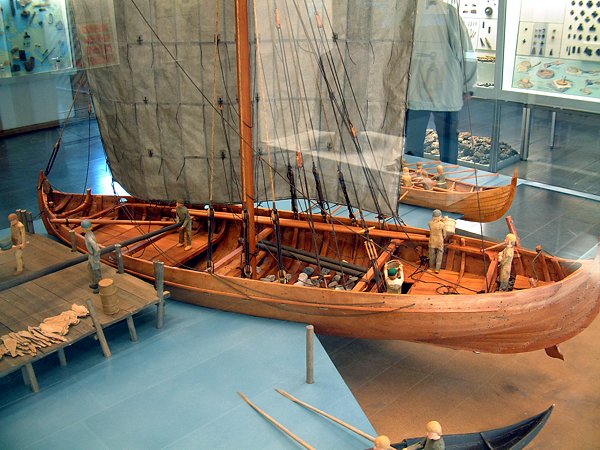
The Middle Age also sees the heavy Corbitas, Roman era cargo ships, having a sort of offspring in the form of a marriage between this type of ship with heavy load and the excellent marine qualities of the Drakkars, which will give the Cog and the Nava, Then the Hulk, a massively reinforced nava, ancestor of the carrack. The Ships, like those depicted on innumerable coins or as a symbol, were undoubtedly the emblematic ships of Europeans of that period.
Navas, Cogs and Hulks will dominate the “Mar Antiqua” and spread throughout Europe from the year 800, taking us until the fifteenth century with the reign of the Carracks and Carwels of the great European explorers.
Scandinavian ships :
- Drakkar (Oseberg)
- Snekkar
- Karv
- Langskips (Skeid, Busse, Sud)
- Byrding
- Knarr
- Moras
Latin Ships :
- Byzantine Cargo
- Byzantine Navy
- Dromon
- Liburna
- Pamphilos
- Khelandion
- Ousiakos
- Spanish Nau (Catalane)
- Crusades Nava
- Trade Naval
- Genoese Nava
- Venitian Merchant Galley
- Half-Galley (Jean de Vienne’s Gallées)
- Siege Galley (1st Crusade)
- Santa Maria Carrack (C. Colombus)
- Caravel
North European Ships :
- Kogge
- Roundship (John Cabot)
- Hansa Kogge
- Hansa Nava
- Clinker
- English Nava
- Hulk
- Dutch Galley
- Gribane
- Balinger
- Birlinn
- Crayer
- Hoy
- Picard
Eastern Medieval Ships :
- Jalbaut
- Annam Junk
- Fou-Tchou Junk
- Cantonese Junk
- Hong-Tchou Junk
- Kin-Tcheou Junk
- Keying Junk
- War Junk
- Treasure ship (Zheng He, 1415)
- Korean Turtle-boat (Geobukseon)
- Patache of Macao
- Patile of Mirlapore
- Boutre
- Kotia
- Batil
- Gayassa
- Dhow
- Batel
- Mtepi
British Roundship
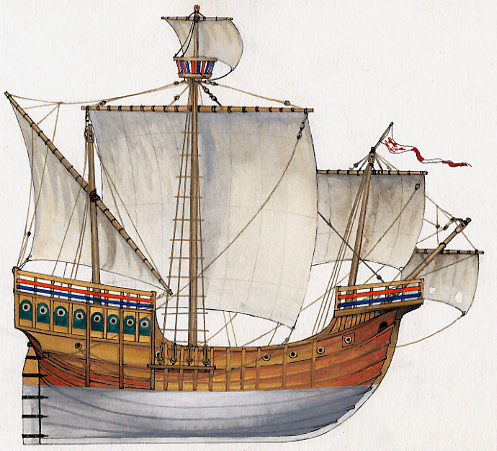
This Northern Caravel was a type of evolved British Round Ship, 3/1 wide (three widths for a length). It had to be around 35 meters for 12 meters wide at the waterline, with 3 decks, and of clinker construction (overlapping riveted planks), all in oak. Its rigging integrated a main sail, upper sail, bowsprit with civadier typical of late medieval Cogs and latin sail on its rear mast. Recent reconstruction of a discovery ship in Bristol sailed by John Cabot in 1497 from Bristol to North America.
Clinker
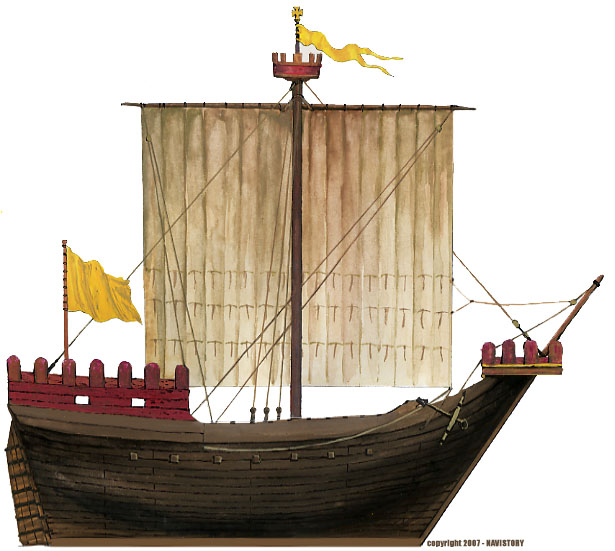
The Clinker was another name for the Cog (In French and English), Kogghe (in Batavian), Koggen (in German) or “Coque”, from the Spanish Coca or Cocha, or Concha in Latin, Coccha in Venetian. This was typical of the versatile cargo ships of northern Europe between the early Middle Ages and the era of great discoveries, although this type later coincided with the nava, more typical of the Lateen-rigged cargo ships. The clinker kogge was the first and most emblematic of these northern ships.
It was not created as an imitation of the nava but rather a derivative of the Scandinavian cargo ships, lined with clinkers, while in the Mediterranean freeboard construction, as in the past, Predominated. The Kogge was above all a functional, very large and belly-ish cargo ship: 3 to 1 ratio, rarely more than 30 meters long and 150 tons. She possessed only one mast, but in the fifteenth century two or three, before turning into a carrack.
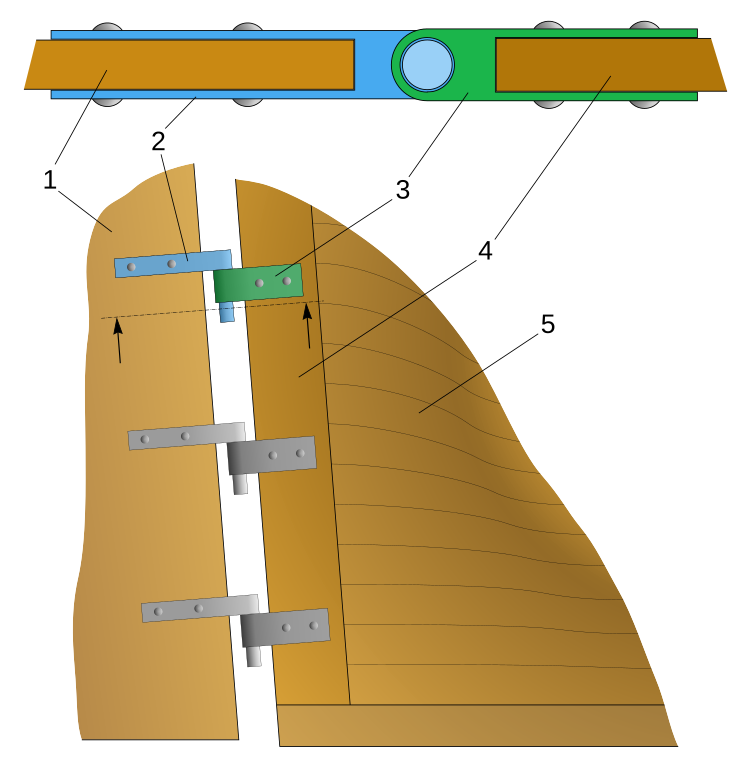
Classical kogges primarily used primarily in the Baltic by the rich merchant cities of the Hanseatic League united in 1241, were built in oak with ash couples, and with a deck clearing a large hold. Their slowness was to be Compensated by better management of the hold, well-closed bilge panels to avoid flooding, and a single sail. The small bow mast, served only to to suspend a small square sail for harbour duties. The hull was often reinforced by transverse beams, like those showed here.
Quickly adopted by the British who also produced a local version of the nava, the Roundhip Cog had a raised platform for archers and a small front forehead almost always rectangular. The stern post was almost straight, supporting a large rudder with straight bar, the transverse lever system only appearing much later. The hull was quickly adopted in the Mediterranean, with local constructions, such as the freeboard, and a rounded bow instead of right. In fact they were almost identical to the naves. This ship dominated trade waterways for three centuries as an all-purpose do-it-all ship, evolving by first adopting a mizzen carrying a Lateen sail on the quarter-deck and then a short bowsprit carrying a small square sail. From the Clinker derives the Hulk, and then the carrack, the classical XV-XVIth Cent. large northern ship.
Trade Nava
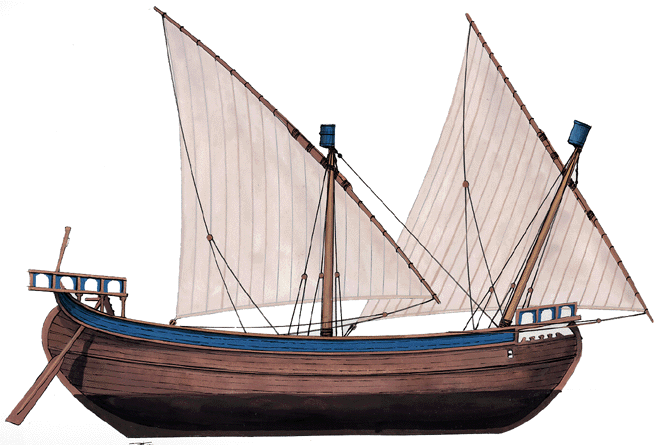
The Trade Nava was well used in the medieval period, in the Mediterranean, strongly influenced by the Byzantine cargo ships, from which she shared many characteristics, including the galley-type rear, tilted front mast and Lateen sails. The Franks made great use of it in the Mediterranean, also marrying square sails to this rigging. It was called “Nef Marchande”
Snekkar
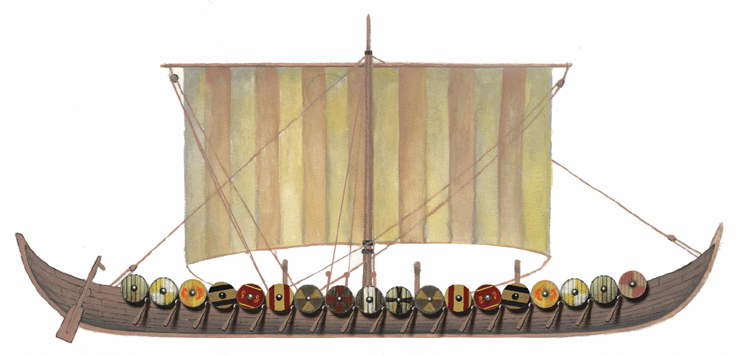
Although less prestigious than the Dreki (from which derives “Drakkar”), Snekkars formed the bulk of the Scandinavian “Langskips”. The Snekkar (“Snake Ship”) is a very ancient Scandinavian term for distinguishing certain warships among Langskips. The name “snake” which by analogy to the Drakkar of the Western archaeologists will give the famous “Snekkar”, was a reference not peculiar to the figurehead but to the length of the ship or rather to its length/width ratio of 7/1 which Is the lowest of all Scandinavian vessels. Some wrecks discovered had an inferior ratio of 11/1. Such a ship was unstable and designed for pure speed. Therefore Snekkars were very fast warships. Their sails were much less developed than other Langskips as they had to be able to pull down the masts quickly, and propulsion by oar was practically default. Smaller ones (like this illustration above) were not decked and the frames rested on the keel rather than being embedded. Perfectly symmetrical, they were designed so that the helmsman could move his rowing from the rear to the front and the mast was in the center to balance the masses.
Snekkars were clinker-built (overlapped planks like on a roof), scandinavian-specific, but often from green pine, which gave them their great flexibility, or Oak (Like the Oseberg ships). Curved parts came from trees or branches in the desired shapes. Snekkars, known sagas, were probably the main ships of the Vikings from the ninth to the twelfth centuries. These are the ships of great invasions and raids, not the so-called “drakkars” which are mostly a posterior Western invention (although the term existed). Thanks to their large, tightened form, and almost flat bottom they could go virtually unimpeded on all rivers in Europe. On the other hand, they are not strong enough to face the high seas serenely in heavy weather, except the Langskips of the largest dimensions.
The Snekkars are divided into subclasses relating to their rowing numbers: The Tólfoeringr had 12 benches (24 oars), the Fimtánsessa 15 and the Tvitogsessa 20. The latter formed the majority of the Snekkars. The Snekkars were known and used by the Normans under the Latinized name of Esnèque or Seneca. The name was derived from Snekkja, which was borrowed from Snekjur. It was always Herkskips, “warships”. The shields rested on the Skjaldrim, a loose trim that increased buoyancy and protected spray while covering the oars and providing a tie to the shields. The latter could be placed simply consecutively or overlap to form the “shield wall” also used by the Vikings ashore.
Dromon
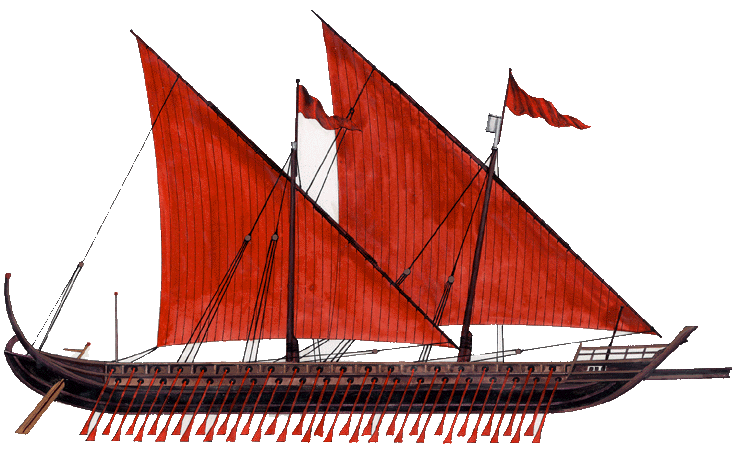
Archetype of the Byzantine war ship, the Dromon ruled over the eastern Mediterranean until the fall of Constantinople.
The Dromon is the most famous Byzantine ship. This fast galley was indeed the standard of the fleet of the Eastern Roman Empire from 800 to 1300 AD. The name evoked speed, but the Dromon was also a general type, including other units. The one that remained under this name was large enough to be much sharper than the heavy Roman quinqueremes, and much faster thanks to the systematic adoption of multiple rowing lines (from 2 to 3 rowers by oar). In general, the Dromon, a bireme, was propelled by 80 oars (for the biggest ones like the one represented above, of 50 by 7 meters), and could total 240 rowers, not counting the 80 soldiers, archers, officers, and crew for ballistae and catapults.
The weapon of choice, which preserved the spur, was of course the Siphon, an archaic flame-thrower, composed of a tube thrusting the bronze lion’s mouth, projecting at large distances the famous Greek fire, a mixture of Tar, saltpetre, sulphur and crude oil that burned particularly well in contact with any surface, including water. Catapults launched incendiary “bombs”, “fire pots”, terracotta bottles filled with the same liquid, that can rain down a thousand meters around the ship. Sand and skins coated with vinegar were the only protections against these weapons. Moreover, the hull of the Dromons was often doubled in copper, in order to avoid the consequences of ramming, so these were also early ironclads. The Byzantine naval domination was also largely due to these ships, much improved over the centuries and soon at the origin of the whole range of specialized vessels, large and small.
Portuguese Carrack: The Nao
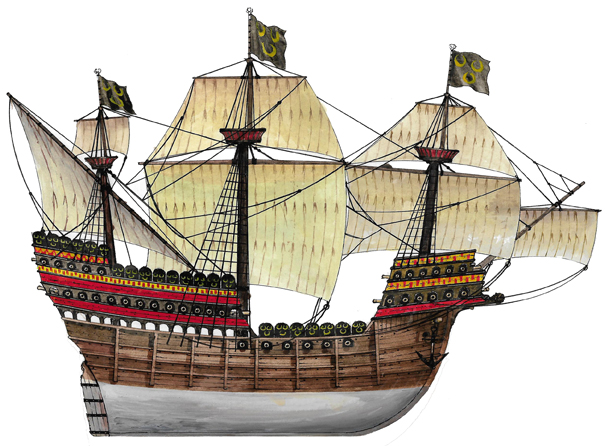
The Nao (lat. Nava) was the generic Portuguese name given to carracks, which were widely used alongside caravels to build the first colonial empire in 1415, extending from Africa to Asia. One of the most well known Nao was the Flor de la Mar (1501 or 1502) recorded in the “Roteiro de Malacca” register. Another famous Nao was the Sao Gabriel, Vasco de Gama’s flagship and the Victoria, Magellan’s ship. These solid ships married Latin and Nordic influences and were well suited to the Atlantic and long travels. Their construction required clinker assembly and reinforcing beams. They had large holds to store food, water, live animals, an iron worker, a millstone, glassware for barter with indigenous, but also weapons and gunpowder to show strength. Artillery however was overall modest (gun port had just been invented) consisting in a few heavy pieces and a large majority of smaller calibre breech-loading swivel guns and swivel-fixed arquebus in the castles. The idea was more to frighten and impress the locals than to fight against possible encounters at these latitudes.

Dreki (Drakkar)
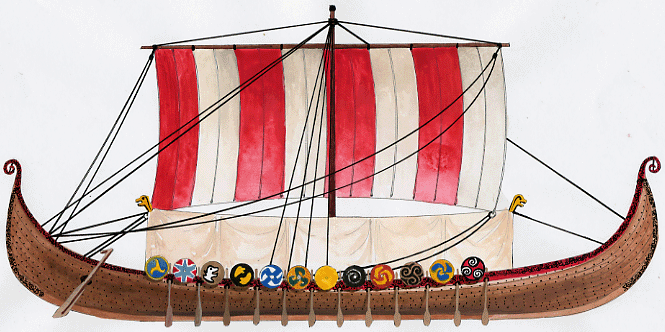
Oseberg’s ship was very well preserved and is a masterpiece of shipbuilding, now an icon of Scandinavia.
The famous Dreki or “Dragon-ship”, is a romantic invention of nineteenth-century archaeologists probably inspired by the real “Snekkar” with a snake-shaped figurehead. In fact it’s a type of Langskip (“long ship”, the true raid type Viking ship) which appeared in the 8th century AD. Its ancestor, the Byrding, was assimilated to a boat without sails, which nevertheless possessed many of the langskip peculiarities. However, there was a common ancestor which was close to it, dating back to the 3rd century BC. Possibly the first clinker-built boat, with overlapping planking such as the tiles of a roof. This technique allowed a better strength in heavy seas and storms, frequent in these northern latitudes, but also ensured a greater impermeability. They had a lacing of couples in roots of spruce, giving them great flexibility. In this they inherited Neolithic skin boat.
Drakkars are basically large symmetrical boats, able to reverse quickly if needed, with low draft and flat bottom, but also often without decks. The mast, short and always single, was placed in the center of the ship, stuck in a bulge of the master-couple planted on the keel.
This mast could be dismantled for manoeuvrers, but at sea it was almost always sufficient for the propulsion as there was no shortage of wind. But this is especially the finesse of the ship’s lines that made her legendary: Bow and the stern are high and very narrow, even though the center of the ship is wide and with a low rounded section and flat bottom, giving this ship excellent stability but also excellent penetration and low drag.
The oars were manned by a single man in general, used mainly for river, bays and cabotage, where the shallow draft allowed them to go everywhere. It is often forgotten that these ships also traded a lot, therefore river cities (which abunded throughout Europe and Russia) were always capable to reach almost every of them, how deep inland they were, like Kiev (now in Ukraine).

The strikingly handsome lines of the Oseberg ship are worthy of an art museum
Contrary to a widespread idea, Drakkars did not systematically showed a Dragon head at their prow and/or stern, but more often a spiral, sacred symbol widely used graphically by Celtic and Scandinavian peoples. Their hulls were also often ornamented with patterns of the same order proper to the Drekis, the type of Langskips related to the Snekkar but generally much more decorated. The Oseberg boat was discovered in 1904 by a farmer from Oseberg, in the Vestfjold region.
The latter had in his field a tumulus containing a vessel well buried, probably belonging to Queen Åsa and her maidservant. She was exhumed and preserved byarchaeologists Gustavson and Shetelig. This was not the first exhumation of a medieval scandinavian ship, because others had been cleared as early as the seventeenth century. But the gorgeous ornamentation and perfect state of conservation were a first. So the Oseberg is technically a “Dreki” not a Drakkar/Drekkar. By the way, “Viking” is not a people but the adjective “raider” or “Vikingr”.

Details of the decoration
As a Langskip, the Oseberg was rather short and wide (22 meters by 5) but was particularly unusual form was emblematic of the Dreki and Snekkars in general. Dated from 820 AD. JC. she was built of oak, with fifteen benches, probably for 30 rowers, which was not large. The mast was about 9 meters high and the sail was about 90 m2. She had to be able to sail at 10 knots just by wind power. The well-worked decorations of the stem piece (perhaps because the owner was a woman?) became classic examples of Norwegian pagan art. In truth, the Oseberg’s ship was so small she could also have been classed as a Karfi, a short variant of the classical Langskips like the Snekkars.
https://en.wikipedia.org/wiki/Oseberg_Ship
https://www.khm.uio.no/english/visit-us/viking-ship-museum/exhibitions/oseberg/
https://www.vikingeskibsmuseet.dk/
Langskip Sud
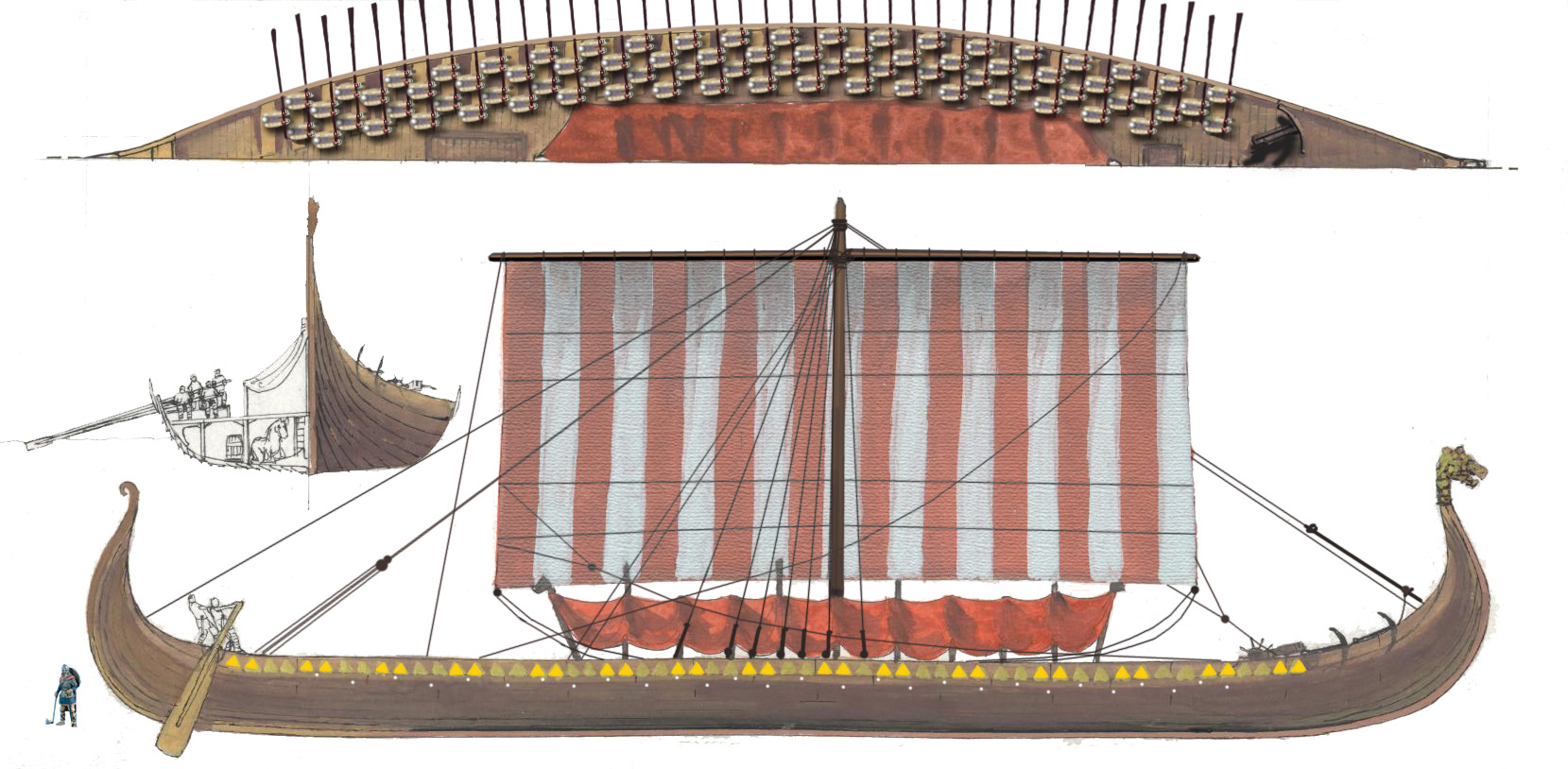
The Sud was the summum of the largest Langskips, a late type for worlwide expeditions.
Langskips (restrospective translation of Latin “navis longa” meaning “long ship”) were elongated, fast and narrow war ships used by the Scandinavian peoples from the very beginning of antiquity (Hjortspring boat (400-300 BC)). The larger ones were classified as Snekkars, of which the Skeid and Busse (Bússa) were well-known types. Among the most famous of the ancient texts, the Ormen lange (long serpent), Busse of Olaf Tryggvason (King of Norway in 995-1000) was renowned with its 45 meters length and 68 rowers divided into two series of 34 row banks.
She was also known as high as a Knarr, characteristic of heay duty Busses. There was no doubt that these large fully decked ships had enough space for horses in their cavernous holds and large space for workshops, forges and all what necessary for long expeditions.
The illustration vessel, a large Sud, is an example of the largest Langskips ever built. Built in old Oak, with a crew of more than 170 men (including 154 rowers, mostly divided into double rows on a double set of 20 alternate oars), was equipped with grappling hooks and four anchors. The oars were so heavy that they were manoeuvred by two men each. This ship was about 50 meters long by 10 meters wide, which was still possible with the building techniques of the time used for Knarrs.
The Gokstad and Skuldelev ships, stronger than the Oseberg, were reconstructions of these great Langskips, the 24-meter-long Gaia and above all the Skuldelev 2, over 30 meters long as described by the Sagas, and restored by the Roskilde Museum team. The Sud was even more impressive.
But the Busse had between 40 and 70 rowers and a much lower freeboard but the Sud (Súð) described by Sagas had about 300 men on board. Such a figure indicates that they had to have about 70 oars with swim, which gives in analogy of 80 meters, which seems incompatible with techniques of construction of the time… We know however that at least two ships corresponded to this late typology well after Viking invasions era, in the thirteenth century, such a the Mariasuden and the Kristsuden (1262).
The latter, built by King Haakon Hakonsson, had 37 oars on each side, 74 in all, probably 148 rowers. The double, or even triple (220 rowers) double swim was induced by the length of the oars. Reported to the rest of the manoeuver crew and to any additional embarked warriors, these Langskips could actually approach the 300 men.
In any case, the largest Sud Kristsuden was described as having 37 sections, ca 52m according to the old measurement systems: Keel and lots were 74 so about 40.7m, but with the addition of the Stem, stern, bulkhead and decorative elements; ca 11.3 m more. The ships with 40 sections were 57m long.
Links & sources:
https://home.online.no/~joeolavl/viking/index.htm
https://avaldsnes.info/en/viking/vikingskip/
https://www.khm.uio.no/besok-oss/vikingskipshuset/
Byrding
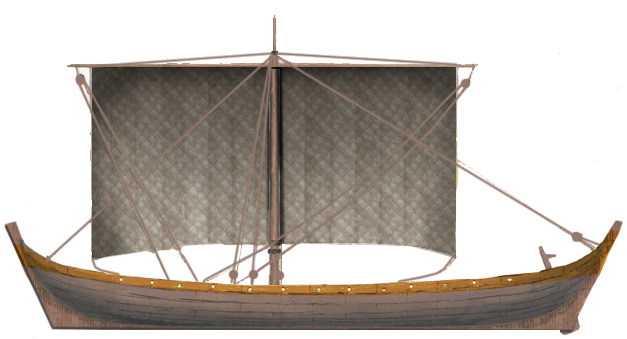
Like most Viking boats tied in sagas, the Byrding is quite old difficult to date until a wreck is found. The Byrding was a smaller version of the Knarr, smaller even than the Karv, a merchant coastal vessel. It was narrower than the latter, and also shorter (an indication of size is given through record of it having between “10 and 15 rows” – spaces between the benches). Probably, its size should have been around 12-17 meters.
It was midway between the Karv, half-civilian half-military design, and the Knorr, a pure cargo boat. With large sails, these were thus considered very good walkers, fast, with straight bow and stern cutters.
This boat was also capable of deep-sea navigation over respectable distances, such as between Iceland and Norway. During the great military expeditions, they were probably used to carry everything that the great langskips could not carry like food and water. With Christianization and adoption of southern roundships, the Byrding began to disappear.
Knärr
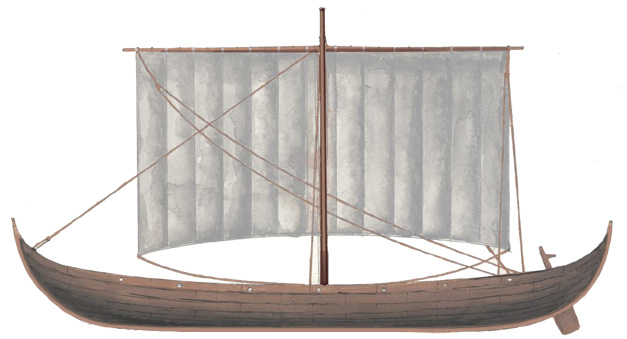
The Knärr was essentially a small Scandinavian boat with most characteristic of standard Viking boats.
The Knärr or Knorr is the best known and most widespread of the Norwegian cargo ships (“Kaupskip”). It was characterized by dimensions rather short in length compared to Langskips but the ratio length/width was much higher (1/4 or even 1/3). Draft was also higher, and most of these were decked. The Knärr was devoted to carry various trading goods like walrus ivory, wool, furs and pelts, armour, and weapons or even slaves but also honey, timber or wheat.
The sail was therefore important for propulsion in comparison to rowing, mostly limited to manoeuvrers, and the rowing ports were often relegated to the rear and front, clearing the central part, where the load was placed on the the highest, longest Knorrs. The largest (about 20-30 meters long) fully decked received forecastles on both ends so that the passenger sheltering from the heavy weather do not share the middle deck with animals. A wreck of a Knarr known as “skuldelev” was found in the port of Roskilde, site of the famous museum, measuring 16,50 meters by 4,6. Its chords were much closer (80 cm for the Gokstad langskip and 74 cm for the Skuldelev Knarr).
Construction remained close to Langskips, but much stronger. Often Knarrs had a straight stem and stern, and a lower sailboard nailed rather than knotted. Framing was also thicker. Knarrs were reputed to be good long range seafaring ships, able to follow trade routes from Scandinavia to the Mediterranean since descriptions of these ships are reported by Arab merchants.
This type of ship was essential to the great Viking explorations, allowing colonies to be founded in Ireland, England (York), Russia (Novgorod), Iceland, and at the time of Erik the Red, south-eastern Grönland. His son Leiv Eriksson, had a fleet of these ships that landed in Canada (founding a small colony of Helluland, Baffin Island, Marksland on the Labrador Coast, and Vinland in Newfoundland) when accidentally attempting to reach Greenland nearly 500 years before Columbus. Knarrs used for these expeditions as described by sagas were tall, with up to 35 rower, sub-types known as the Grønlandsknarr and Vinlandsknarr.
Moras
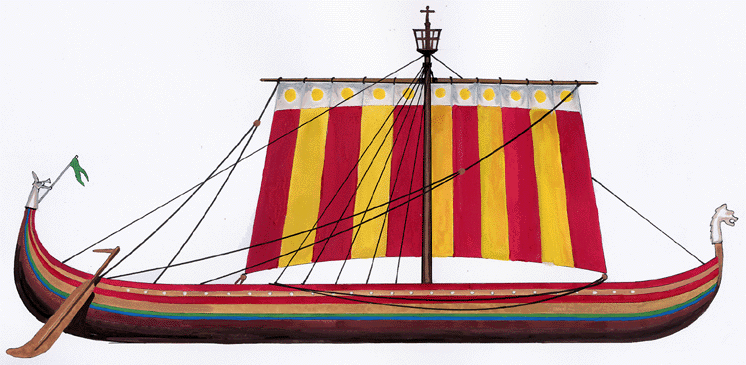
Very colorful, the Moras were related to the Scandinavian Langskips.
The “Mora” is the name given to the name and place of the place of conversion and acceptance of the sovereignty of the King of France by Rollon, Viking. With him, and his successors, Scandinavian shipbuilding was married with Frankish techniques. Thus, the Norman boats were characterized by certain similarities to the Scandinavian Langskips, including the Lion or Dragon head, the folding central mast, the fixed steering rudders, but also a specific construction profile, taller, wider and stronger to carry cavalry.
They were judged to be more stable but slower. They were also perfect for carrying a cavalry,the strong point of the Norman army. Their average size ranged between 12 and 24 meters and they could carry 20 to 30 rowers, who were also warriors. In 1066, William the Conqueror built several hundred of these ships (nearly 900) to disembark his 15,000 warriors on the coasts of Great Britain. This episode and the ships he built are very well known to us through the very long tapestry of Bayeux, which shows of the very colorful Langskips.
The Byzantine Navy
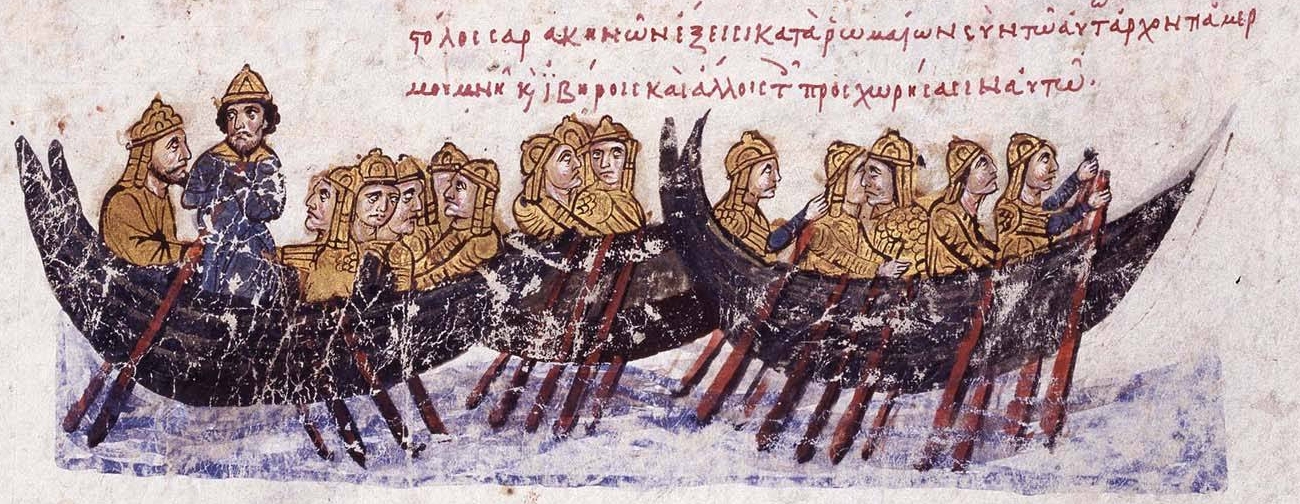
Byzantine manuscript of the eleventh century describing the invasion of Crete by the Saracens in 820
HISTORY of the Byzantine fleet (324-1453):
The Byzantine Navy was born with the schism between the Roman Empire of the East and the West. At that date it was composed of the local Roman fleet in charge of the eastern Mediterranean, which had evolved since the decisive battle of Actium in 31 BC; giving the Roman Empire its full control of the “Roman lake”. The Roman fleet in 300 AD was a relatively light force destined for escort and piracy missions.
The bulk of his forces consisted of Liburnae, a fast and modest tonnage ship, whose specificity was to have double swims, like Illyrian pirate ships of the same name. They had evolved, moving to two rows of superimposed swimming, and had grown elongated and weighted significantly, while remaining very fast. Until the adoption of the redoubtable Greek fire, ballistae formed the bulk of embarked armament.
Having an open bridge, these galleys had only reduced troops. It was, in a sense, a return to the frail triremes whose speed and capacity of ramming supplemented the lack of combatants on board. These fleets were nevertheless under the direction of great admiral vessels, heirs of the fifth.
The only confrontation to which these fleets took part was the battle of the Hellespont in 324 AD between Constantine the Great and Licinius, won by the first in spite of lower forces, but better manoeuvred in the narrow defile of the Dardanelles, and allowing him to land his troops in Asia Minor in order to lead the final battle of Chrysopolis and become emperor undisputed.
As a result, the Byzantine fleet stationed at Mysene became the most powerful in the Mediterranean. The Roman empire of the West saw its naval forces quickly weakened by the indirect effects of the barbarian invasions (notably the lack of manpower and funds to maintain it, reserved for land-based clashes). A threat came from 420, that of Genseric, the Vandal king of Carthage, whose naval forces dominated the western Mediterranean.
A large expedition of more than 1100 ships and 100,000 men under Basiliscus failed sharply, putting the empire almost bankrupt, forcing it to a humiliating and very costly peace. The situation improved after the death of Genseric in 477.
The first uses of naval incendiary throwers dated from the confrontation between Admiral Marinus for the fleet of Emperor Anastasius I and his rebellious Magister Militum, Vitalian, which brought together a fleet of 200 ships in 513. It was not not in all likelihood of the siphons with Greek fire, but of another system precursor. It should be noted that the pots (amphorae filled with bitumen or inflamed pitch) were used from the Hellenistic period.
20 years later, Belisarius was sailing in North Africa with the head of 15 000 men transported by 500 Ousiakos with the support and the escort of 92 Dromons. The latter had become the spearhead of the Byzantine navy, which became the most powerful in the Mediterranean.
In 550 under Justinian, it crushed the Goths who had mastery over the Adriatic and the Tyrrhenian Sea, and in 626 intercepted and destroyed the invading Avar fleet, which was preparing to cross the Bosphorus to lend a helping hand to the Goths. What followed was the siege of Constantinople, and the passage of the Sassanid Persian armies.
From 640 however, a new threat came with the advent of Arab Muslims in Syria and Egypt. The Arabs had access to the ports, ships and manuals of the local Byzantine fleets and copied their organization on the latter.
This threat resulted in a crushing defeat of the Byzantines at the battle of the masts in 655, which followed the capture of Cyprus. Byzantium lost most of its fleet, 500 ships. The years that followed were crucial for the survival of the empire. The Constantinople seat of 674 was raised by the use of a handful of buildings equipped with flame-throwing siphons, projecting the famous “Greek fire” or “Greek fire” whose nature remained a mystery for a long time.

The “Greek fire” in action. It was undoubtedly the most amazing weapon of the Middle Ages
This famous Greek fire was a highly flammable substance contained in a kind of large metallic “syringe” actuated by a Syphonarios. The latter, fighting on land, had their “portable” armament, a reduced version, but capable of projecting flames at more than ten meters. The naval version was much heavier and vast so as to have reserve, and a very long tube. The dromons that were equipped with it were called “Siphonophoros Dromon”; the tube passed through a dragon or lion’s mouth.
The Greek fire was able not only to fire the enemy ship, but also the water around it. Attempting to extinguish it with more water only exacerbated the fire. It was the best kept secret of the empire. Grenades filled with sharp points and this liquid were also projected by catapults, like incendiary bombs.
These weapons and general quality but also the perfect organization of the navy, especially reorganized under Justinian II, allowed the Byzantine empire to survive the Muslim maelstrom.

Byzantine spec ops: Attack swimmers. Oppians Cynegetica: “Naumachia”
In 718, a second siege of Constantinople failed, once again thanks to the Greek fire. A last great confrontation opposed in 747 the Byzantine fleet, though inferior in number, to the combined fleets of Syria and Alexandria of the Umayyad Caliphate. The victory ensued the naval mastery of the Eastern Mediterranean and was accompanied by very severe restrictions on Arab maritime trade.
Beginning in the 820s, the Byzantine navy slowly eroded. After 859, after a series of defeats, the Byzantines and Christians were on the defensive, and the Arabs had control of the sea. The Byzantine revival was to take place during the reign of Macedonian emperors, from 867 to 1056. Despite the loss of several thematic fleets in the Mediterranean, the Byzantine navy was going to try and partially succeed in the reconquest of the Mediterranean.

Galley bearing the body of Saint John Chrysostomos to Constantinople.
One of the most famous episodes occurred when attempts were made to retake Crete, the advanced base of Muslim pirates in the Aegean Sea. No fewer than 20 Dromons escorting 64 Khelandions and 10 galleys were sailing towards the island in 949 with 4,000 men on board but failed, countered by the army of the Emirate of Crete. In 960, a new expedition led by Nicephoros Phocas, taking 100 Dromons, 200 Khelandions and 300 transports (Ousiakos, Hippagogue with 77,000 men, succeeded this time to disembark and crush the Muslim forces, and marked a decisive turning point.
Thanks to this advanced base, the Byzantines succeeded in subjugating Cilicia, resuming Cyprus, and settling in the north of Syria on a solid line of defense, averting the Muslim peril in the eastern Mediterranean.
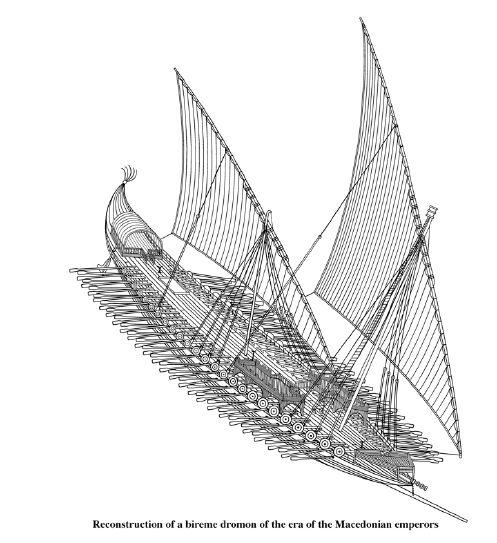
A Dromon of the tenth century, according to the manual Tactica of Leo VI the wise. The very fine spur of the front is nothing more than an ornament, the Latin sail and the orientation of the yards, the size and position of the masts would become a standard, the position of the “castles” before and on the flanks, intended to receive the siphon (at the front) of the smaller siphons on the flanks or of the light jet weapons.
The gallery at the back and the plating ending in two volutes to the antique is characteristic. The width is large, a central bridge is relatively spacious for the fighters, the rowers were a level below. the hull is not a large pontoon almost parallelepipedic like the old heavy antique galleys, but affects a marine and tapered form, inheritance of the pirates ships with a reduced draft.
This ship was the battle-horse of the Byzantines, and was copied as much by the Arabs as by the nascent Italian cities-Genoa and Venice, which improved them. They introduced the triple Scaloccio swim, and cannons into the forecastle. There is no evidence that the Byzantines belatedly adopted cannons on their galleys…
It was undoubtedly the last glorious ages of the navy. Under the Comnenes, in the eleventh century, lack of consideration, funds, competent officers, corruption and negligence, she was no more than the shadow of herself. It was deplorable that it was limited to the transport of goods, avoiding fighting if possible.
If the Arab threat had passed, a new power in the west threatened the Byzantine naval dominance in the Mediterranean, that of the Nromands installed in Sicily. The latter attempted to invade Greece but were held at bay by the Venetian fleet then in full swing, generously funded by a Byzantine empire on the brink of ruin. The exclusive commercial agreements between the Serenissima and Constantinople were the starting point of the Venetian naval dominance, a veritable thalassocracy.
Alexis Comnene, however, attempted to trace a modest fleet that was plainly effective, which he bequeathed to John II, who took care of it without strengthening it. the land army had priority, as in the rest of imperial history. Manuel I was more ambitious and succeeded in rebuilding a powerful fleet.
With this instrument of naval projection in the modern sense of the word, he built a real amphibious fleet which in his time was the admiration of William of Tire. Several operations were launched. Corfu and several Ionian islands in the hands of the Normans were taken over by a fleet of 500 galleys and 1000 transports in 1148. In 1155 another expedition allowed the Byzantines to regain their footing in southern Italy.
In 1169 another expedition was launched by Andronicus Kontostephanos in coordination with the King of Jerusalem, mobilizing 20 large Chelles carrying siege weapons to resume footing in Egypt, 60 chellers transporting horses and 150 Dromones. Despite the impressive device, the invasion failed and a large part of the fleet was annihilated in the heavy weather on the way back. The last expeditions in 1171 against the Venetian fleet of chios, and against Egypt in 1177, failed, and again the Byzantine navy was in decline, bound up with the rise of piracy.

Under the dynasty of the Angeloi, the fleet struggled to reunite a hundred galleys to launch various operations of reconquest. From 1185 to 1196, all these operations were rarely crowned with success. The finances were such that in 1196, only about thirty galleys were able to survive. In fact, the Venetians had mastery over the sea.
Venetian and Genoese galleys were also rented at the price of new commercial exclusives. Under the Palaeologists, efforts were again concentrated on the navy, which never reached the previous level. The only recorded success was the reconquest of a few islands from the Aegean sea to the Latin. The bulk of the fleet, which reached nearly 80 ships in its paroxysm, consisted of private galleys operating under the Byzantine colors. A “naval mercenary” often of Genoese origin, the traditional enemies of the Venetians.
From Byronikos II Paeologus, in 1282, the Byzantine fleet was considered expensive and was dissolved in favor of the punctual rental of Genoese galleys. But it was insufficient in the face of the growing power of the Turks.

His little son Andronikos III attempted to rebuild the fleet in 1330, but it did not exceed 200 buildings, mostly mixed (merchants). During the civil war of 1341-47 the fleet took an important part of the operations, and John VI Kantakouzenos was not more fortunate to reconstitute a fleet, built elsewhere in Venice.
A naval battle combined with the Venetians against Genoa was another sharp failure. From then on, the Byzantine “fleet” comprised only a handful of galleys. It was of no help during the Turkish siege of Constantinople in 1453…
Ships Organisation
The sometimes dubious and divergent sources on the Byzantine navy do not allow a clear and reliable description of the Byzantine fleet. It is towards 911 that it is best described. It is at this time that it is experiencing its strongest growth, with nearly 34200 rowers for about 4000 “marines”.
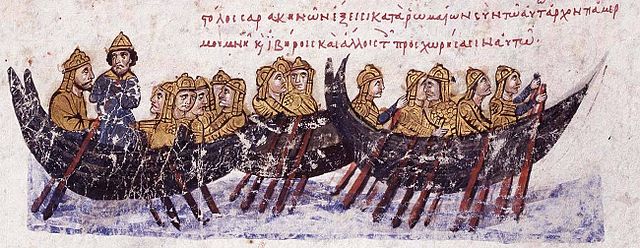
The latter are troops embarked by trade, “Tagmata” very trained and efficient. In the ancient tradition, rowers were not slaves, but free men of low social status, spared, trained, and touching the pay. For the Crest expedition, the fleet consisted of nearly 300 ships. But the composition of these fleets was varied, and some of these ships, more fit for transport than for war.
The local fleets were organized in Themes, like the army, and were subordinate to them. They were commanded by a Drungarios, assisted by two imperial officials, in charge of the Thematic administration. The protomandator was the commander-in-chief, right arm and military career, assisting the Droungarios, often appointed by the emperor. This Protomandator directed the Kometes or “Counts”, the subdivisions of the Theme or squadrons commanded by Tourmarches, and the squadrons by drungariokomes.
Each ship was commanded by a kentarchos (“centurion”). The crew itself was dissected according to the size of the vessels in units of about 110 men, the Ousiai. The rowers of the upper row were also equipped for combat and had to leave their oars in the event of a collision. The officers were Bandophoros or second, assisted by two protokaraboi, more or less equivalent to quarters-masters. The chief officer was the Proreus. There were also spacialists like the Siphonatores in charge of the flamethrowers.
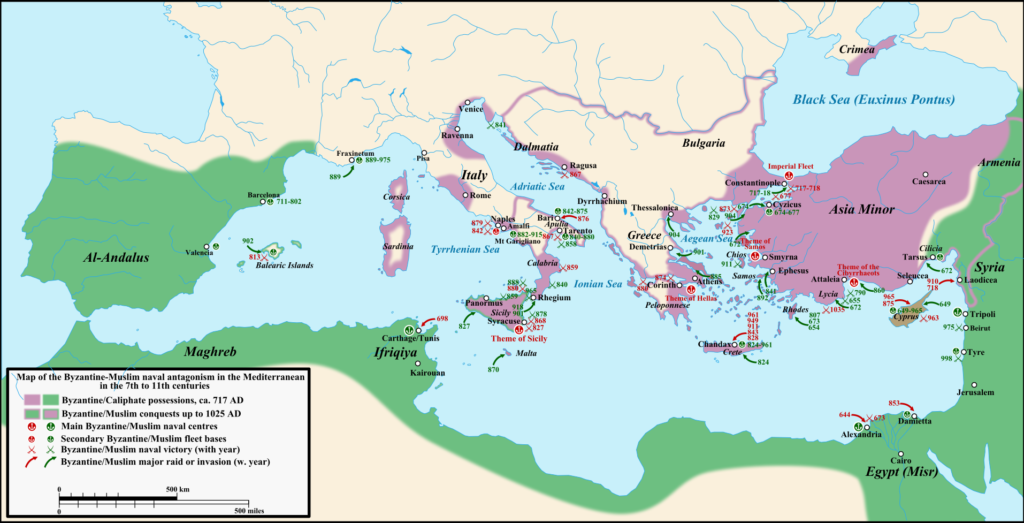
This organization ended with the reforms of Alexis Komnene, which dissolved the themes and unified the fleet. The hierarchy only included the Megas Doux, assisted by the Megas drungarios of the fleet, and later of Amiralios for the squadrons. Under Michel VIII Paleologue, a new reform was based on Greece itself, to equip a local fleet which was not of foreign composition (Geno-Venetian).
The “Marines” were a separate unit, composed of “Tzakones”, “Lakones”, and “Gasmouloi”. The rowers were also grouped into “proselontes” units, all of them small landowners granted by the empire in exchange for their service, and stationed in Byzantine settlements.
The warships of the Byzantine navy were originally derived from the frail Roman Liburnes, “monoremes” having two rowers per side. The first Byzantine liburns were merely enlarged derivatives, but always with two rowers per bank. By shifting the benches and adding a third rower, these vessels evolved into galleys with two rows of oars, the famous “Dromons”, which spearheaded the Byzantine navy.
They were described as heavier and bigger than the liburnes, and much faster and more agile than the old quinqueremis. They formed the basis of the future Italian and Arab galleys in the Mediterranean. The Dromons remained open-bridge ships, and consequently their troops were limited. On the other hand, the upper rowers were equipped to take part in the collision fighting.
Liburnai and Dromoni formed the bulk of the fleet, the troops embarked by merchant ships requisitioned. The latter were small cargo ships sailing alone, and therefore tributary to the winds unlike the large military galleys. Being no more a sea people than the Romans, the Byzantines had moreover to face maritime losses as great by sea fortunes as in combat.
By 920-960 the Byzantine fleet reached its golden age, and the maximum of its development. In addition to the dromons, two other smaller galleys were set up to replace the Liburnoi, the Ousiakos, manned by 108 men, a “ousia”, hence their name, and the Pamphile, having 120-150 men on board. A derivative later made its appearance, the “Khelandion-Pamhpylos”, or Chelande-pamphyle of 200-250 men.
A new type of large warship had indeed appeared, the Chechen or Khelandion, much more armed than the Dromon, and having more than 300 men on board. These large galleys were also used for the transport of powerful jet weapons, and were used for sieges. Very modern “amphibious” derivatives appeared, like the “Thyreokhelandion” or khelandion with doors, true LST before the letter, since in their flanks they transported between rows of rowers, troops, equipment and horses for a campaign.
The galley ran aground on the sand from the front, and two flaps were simply opened at the prow. Lateral footbridges had also been developed for the Dromons, which also served as troop transports. The Ousiakos, literally “servants”, were small utilitarian galleys carrying all the supplies and were included in the convoy, arriving last when the area was taken and secured. Another type of amphibious ship which was developed, was known as “hippagoga”. The concept was soon adopted by the Crusaders.
the dromons were fully decked, with a Xylokastron or forecastle (lit. “wooden tower”), the top in which the siphon was mounted, and two lateral docks on which were added additional light siphons. This fellow was later kept on the galleys of the Middle Ages. The word “galley” was derived from the small “galea”, a monoreme with only one rower per bench, used as a scout, liaison ship and despatcher.
These vessels were initially propelled by square sails, but gradually the Levantine sail appeared and supplanted it, giving the Latin sail, with mixed rigging that survived until the 19th century on derivatives of galleys like the polacre. Codes of tactics and manuals were long used as rferences, and were studied and translated by the Arabs. The use of flags and lanterns in order to pass orders was prescribed, a usage which persisted throughout the history of the sailing-ship.
Various tactics were established, but since the spur was no longer a weapon, but present as an ornament and protective element of the prow, naval battles were carried out in attempts to break the enemy line, with maneuvers, followed by shots, katapeltes firepots, and finally boarding. Although “Greek fire” is a scary weapon, it was not the decisive weapon expected: The siphons did not equip all ships and were only effective in calm weather and very short distances. More “classical” projectiles launched from mangonels (catapults) and Toxoballistrai (ballista), arrows, stones, lead blocks, tripoints (triboloi) were used more readily, according to some authors, snakes and scorpions in pots of terracotta…
The Byzantine Marines were experienced fighters, heavily equipped with lamellar cuirasses and armed with short pikes, sword, and javelins. It was a melee combat infantry, assisted by lightly armed rowers of the first rank and wearing cuirasses and leather caps, while sailors posted in the masts threw javelins, stones, and arrows. From these fights depended on the outcome of the battle…
So to simplify the nomenclature in the 10th century:
Three main classes of bireme: -The Dromon (crewed by two Ousias)
In De Ceremoniis mentions are made of the heavy dromōn carrying 230 rowers and 70 marines. Either supernumerary crews or for the second rower on each of the upper-bank oars.
-The [chelandion] ousiakon ([χελάνδιον] οὑσιακόν) (as detailed in the inventories for the Cretan expeditions of 911 and 949) manned by an ousia of 108;
-The [chelandion] pamphylon ([χελάνδιον] πάμφυλον) (120–160 men) possibly from Pamphylia or with “picked crews”
Light ships
-The monērēs (μονήρης, “single-banked”) or galea (γαλέα, from which the term “galley” derives)
60 men crew, inherited the antiquity small vessels, used for scouting missions and in the wings of the battle line.
The galea was strongly associated with the Mardaites (Christos Makrypoulias)
Super-Dromons:
Three-banked (“trireme”) dromons were rare. But they are described in a 9th-century work (parakoimōmenos Basil Lekapenos). The treatise draws heavily upon references on the Classical trireme however and must be taken with a pincer of salt. Their very existence is attested in the Fatimid navy in the 11th and 12th centuries, confirmed by Leo VI’s chronics about large Arab ships in the 10th century.
Byzantine Cargos:
Transport ships (phortēgoi) were pressed into the fleet depending on the mission, as well as supply ships (skeuophora). These were sailing vessels related to the ancient Roman Corbita and Oneraria. Byzantines and Arab fleet also trusted tailor-made horse-transports called hippagōga, either sailing ships or galleys.
The chelandia appeared originally as oared horse-transports. So the hippagōga were seemingly between the chelandion and the dromōn. When the dromōn became a pure a war galley, the chelandion had a special compartment amidships to accommodate a row of horses. Itwas made therefore beamer and deeper.
The sandalos or sandalion (σάνδαλος, σανδάλιον), was a boat carried along by the larger ships, towed at sea. In De Ceremoniis it was described as having a single mast, four oars and a rudder.
Sources: Wikipedia, admiral J.J. Antier, Treadgold, Gardiner, Norwich, D. Nicolle, Lewis and Runyan, Jenkins, L. Casson, Mac Comick, Haldon, Tougher, Bartusis, and several Byzantine and Arab sources.
Byzantine Liburna
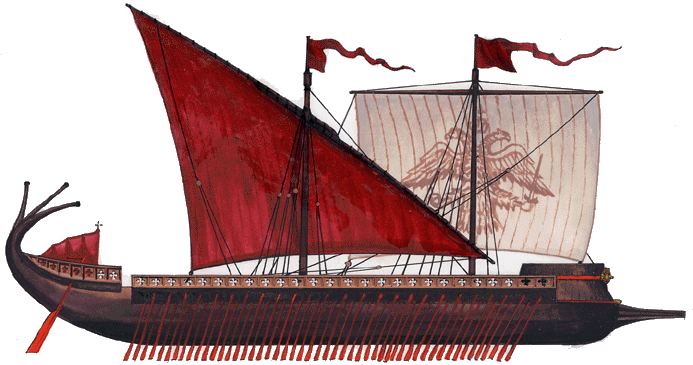
The Roman Liberner was a small moner (a single row of oars), which like the pirate hemiolia used mutiple swim to ensure the most power for the ship’s gauge.
The Byzantine Liburne, on the other hand, has been transformed in time into a galley of strong tonnage, armed in the same way as the Dromon. On the other hand, they often used a mixed rigging of square and latin sails.
The galley above is a large Liburna of the end of the eleventh century, of 100 oars and 300 rowers, with 60 men on board. It is equipped with rotating catapults, two of which are forward on the protected deck of the foredeck, a siphon, a lead dolphin suspended from the yard of the front mast, and could hoist up to the mast of the nacelles protected for archers. The combatants could take their places on the narrow gangways of the bulwarks, the rowers being lower.
Crusades Nava
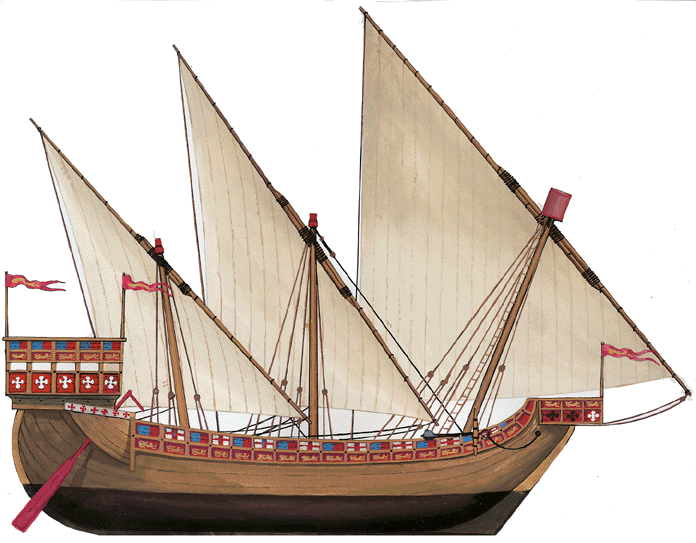
It was on these very special ships that the Crusaders landed in the Holy Land during the First Crusade. The Mediterranean Nave had a mixture of square and Latin sails, but some of them were even closer to the galleys, being lower and only rigged in Latin. Their origin can be found in the Chelandes and especially the Byzantine Usher, a true LST before the letter since it was characterized by a working prow, the ship being stranded on the sand. The Nave above is at the arms of Richard the Lionheart. In general, the lords and the simple individuals who left for the Crusades took a route across Italy, then left Messina to Malta or Crete before joining the Holy Land. Local ships were used.
Khelandion
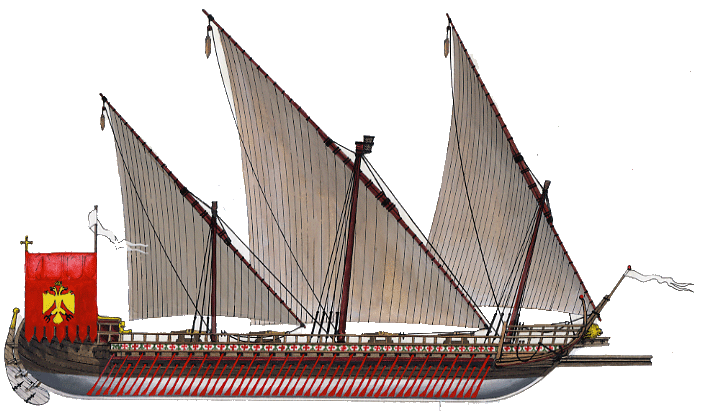
The heiress of the great galleys of antiquity, but having many Byzantine specificities, the Khelandion, or “chelande”, is a type of rowing ship developed to carry goods in addition to its troops and rowers. Developed at the beginning of the 8th century AD, it was a question of answering the problem posed by the great military dromons, which had to embark their supply on two “galleys-servants”, the Ousiakos. In fact, the Khelandion had to be able to do without it and to embark. Representing the top in the typological hierarchy, many served as Admiralty ships to the Byzantine Maritime Prefects, Ravenna and Mysena for example.
The most extensive were 80 meters long, about 10 meters wide, with two rows of oars and five oars rowing in scaloccio. They were, therefore “ten” according to the ancient standards. Written in Latin on three masts in general, they displayed a less important armament than on the Dromons, but still dissuaded, spread over their entire bridge. In addition to the troops embarked (more than 50 men), powerful ballista, made to fire Greek pots (explosive) and other pots full of snakes that threw terror on the enemy ship, but also included its traditional siphon flamethrowers at the front, a spur, and for the collision, leaded dolphins supported by the antennas of the masts intended to fall and pierce the deck of the vessel approached, as well as nacelles for one to four archers suspended from the masts.
La Chelande avait deux dérivées, la Chelande-hussière, un véritable navire amphibie des temps moyenâgeux, capable d’embarquer troupes, catapultes et chevaux en vue d’un débarquement, s’échouant directement sur la plage et s’ouvrant par l’avant. Il y avait également un intermédiaire entre le dromon et la légère Pamphile, appelé Chelande-Pamphile, et qui était en général du niveau d’un petit Dromon.
Catalan Nava
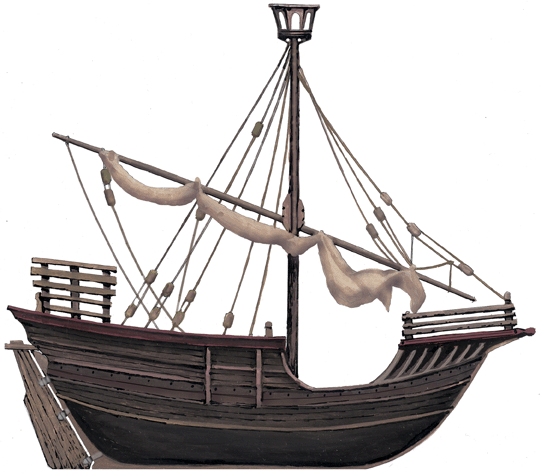
Sober and massive, the shape of this hull is decidedly far from those of the slender Nordic langskips, and immediately call it “nut shell”.
The Catalan Nave above is in fact drawn from a reconstruction closer to one of the oldest ex-votos ever found, dating well before Columbus expedition. The ex-votos are, in the absence of the engravings made by artists who are not necessarily sailors, the best testimonies which have remained to us, probably the most faithful and the richest of information because realized by nature by those who were on board …
There was indeed no plan or instructions relating to the ships of those periods in the shipyards, since the construction techniques proper to each master carpenter were of oral tradition. This nave could have been a caravel both by the forms and by the technique of construction. Even considering possible exaggerations in proportions, these were coasters of small dimensions (25 meters at best), particularly large hull (10 meters for 25, a ratio of 2.5 / 1) advantage for stability and a serious disadvantage in keeping track. The hull was 6 meters high, which meant an ample space on board to match its charter vessel vocation and height was a guarantee in the heavy weather.
Built in oak like the Caravelles, with a front ending in the same way but surmounted by a small castle, the toldilla, a triangular platform backed by lateral “stairs” that surmounted and framed the stern, forming a kind of small post before, which will become the fellow and will assume enormous proportions on the Caracas a century later. The Tolda, the quarter-deck, also served as a shelter for the helmsman handling the large saffron, but it is not known if a mechanism allowed him to better distribute his effort (hoists and drosses).
This Tolda was surmounted by a small poop, observation deck (possibly used to make the point), protected by a simple guardrail. The cargo was well protected in the hold, the access of which was closed by a single small hatch between the mast and the front station. Solidly built, although modest, this very close cousin of Santa Maria had only a reduced sail to a large sail, requiring only a smaller crew, but restricting the possibilities of maneuver. The ship was a coaster, but it was designed to be able to face roads leading from the Mediterranean to the Atlantic and the North Sea.
The original model of this ex-voto is now on display in a room in the Prins Hendrik Museum in Rotterdam. It has been decorating for centuries the vault of the chapel Saint Simon de Mataro in Catalonia and remains one of the best indicators of the construction techniques of this period that remained to us…
Carrack Santa Maria
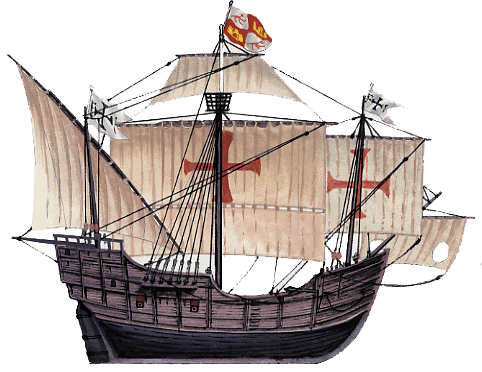
Either classed as a “Nao”, Carrack or Caravel, it was the flagship of Christopher Columbus during his expedition towards “the Indies”. This reconstruction here is that of a Caravela.
At one time Cogs, Hulks, Caraques and Nefs could still be seen (the distinction was made mainly by rigging and tonnage), the Santa Maria proceeded at the same time from the Nao (Nef, Latin name of the Cog of the North) and the carrack. The latter, in fact, were distinguished at one and the same time from a larger forecastle, and often (but not always) had a sail on their foresail.
Their tonnage was superior and they always wore reinforcing portals, whether bordered with clinkers (North) or Freeboard (the Mediterranean, Latin countries). Their dimensions remained in a classic 3/1 ratio, but they were higher on the water with more bulging shapes, and a square stern table. They were also the first to have cannons in portholes. The first unit permanently equipped with canons was the Nao Galicia, in 1400.
It is precisely in Galicia that the Santa Maria was built, and nicknamed “the Galician”. It belonged to Juan de la Cosa was anchored at Palos de la Frontera for his first trip. It was 30 meters long and 10 meters wide, and was 230 tons long and possessed four small portholes. His crew was 40 men. After his shipwreck at Hispaniola his wreck was used as timber for the small fort of the Navidad.
The Santa Maria is inseparable from the Genoese navigator Christoforo Colombo (Christopher Columbus). Classically the latter lives in an atmosphere of merchants travelers, spices and farms from the Far East. Naturally, himself (helped by his family) becomes an experienced sailor thanks to his many trips. In one of them, in 1476, his convoy was attacked by the French and took refuge in Lagos in Portugal, where an important Genoese community is present.
There he meets his wife, Filipa Perestrelo e Moniz, who will give him three sons. Columbus made several trips to the coasts of Africa with the Portuguese merchants and was introduced to navigation and cartography. But he also became aware of the tedious duration of these journeys along the coasts of the great continent and became convinced of the possibility of joining the Indies by cutting directly from the west.
The cornerstone of his belief is that the measure of Potolémée is overestimated, and he himself evaluates the distance to Cypango (Japan) at not more than 2414 kilometers.
He established a file, avoided any questioning of the inquisitors and went to plead in 1485 his project with King Manuel II. The latter, influenced by hostile advisers, refused categorically. Disappointed and wounded, Columbus departs for Castilla and is accepted at the court of King Ferdinand of Aragon and Queen Isabella of Castile. But a first verdict was unfavorable to him in 1490.
He regained his chance in 1491 and this time his project was about to obtain the King’s approval. But the demands of Columbus, when his titles and the power he demanded over the lands to be discovered provoked a new refusal. It was the Queen’s counselor who finally convinced her to accept the benefits expected from such an expedition. In August 1492, Columbus was ready to leave with three ships, the Santa Maria, and two small Caravelles, the Nina and the Pinta, and 90 men.
On 12 October, after a difficult and challenging journey for Columbus, and especially for his crew accustomed to sail by sight and imbued with the frightful stories of sailors on the high seas, threatened the expedition to fail, and Columbus, a poor diplomat, of little to a mutiny, well assisted by the captain of the Nina, Martin Pinzon.
On the 12th of October, therefore, Columbus landed on the island of Guanahani (San Salvador), and greedy for gold, was directed by the Indians farther north, towards Cuba. His expedition finally set foot on the island farther west, baptized at the time Hispaniolia (Haiti). However, sea conditions had rendered the carrack unusable and had been used to build a permanent establishment.
A handful of men were left behind, and Columbus set off again on the Nina, joining the Pinta, who had gone earlier in search of gold to the west. The return is also difficult, but triumphant. It brings back various artifacts, indigenous and animal, but not or little gold, if not promises. He secured the formation of a larger fleet, counting 15 ships and 1500 men to establish a lasting colony.
It leaves Cadiz in 1493 and will approach Navidad to find that there is no longer a soul that lives at the fort, destroyed and whose survivors had died out due to illness and the hostility of the “Indians”. He founded his colony Isabella on another site and stayed for some time to manage it. His idea was always to find gold in Asia, and he set out to explore the south of Cuba with three caravels.
He returned without new discoveries in 1496. On his third voyage, in 1498, he was able to arm only 8 ships, and had to defeat 5 on Hispaniolia suffering from a shortage. Approaching Trinidad, he thought he had at length found the continent. But the situation remains worrying at Isabella and colomb is soon accused of being at the bad manager.
The King sent his councilor Bogadilla to shed light on these denunciations, and his report resulted in the comparison of the brothers Columbus to be tried in Spain; He is actually condemned, losing titles, including that of Governor of Isabella, but receives the endorsement for a new mission of exploration, which will be his fourth and last voyage, in 1502.
Colombus explores the coasts of Honduras, up to to the Isthmus of Panama that he mistook for the passage of Malaysia; But his expedition turned to drama, and he loses his ships. He was saved by the new governor of Isabella, and returned to Seville, but he ended his life miserably, fallen from grace, and passing out in 1506.
Hanseatic Nava
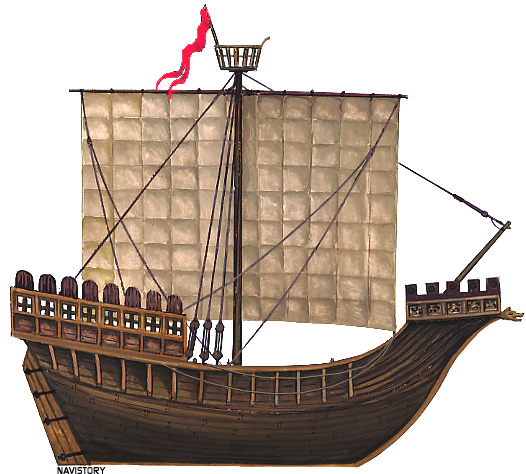
The Northern Nava was a more sturdy and resistant ship, a true precursor of carracks
The Hanseatic Nava, or northern nava, probably appeared in the 12th century, first in the coastal cities of the North Atlantic, in the North Sea and then in the Baltic. It is the perfect illustration of the encounter in naval techniques of the north and the south, bearing in germs the future heavy European ships. While the southern, Mediterranean nave mingled Norman contributions of Scandinavian naval technique with the local Latvian ships, the northern nave saw it as a simple, finer and more graceful declination of line construction than the Kogges of transport in local use.
As a result, the Nordic Nava was preferred as an armed transport ship or even a warship, as the heavy kogge. The lighter construction, however, lent less to offshore navigation than the Kogges, and in the end, Kogges and naves in the north were concurrent to develop their sails and lead to the carrack.
Hulk
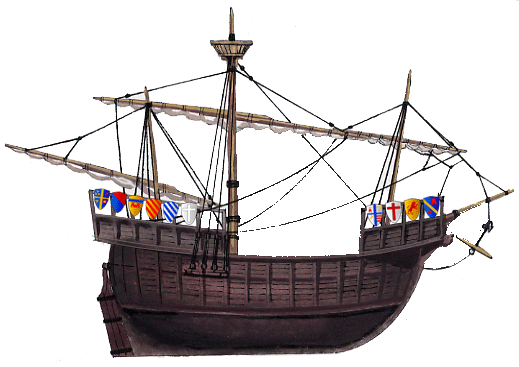
The Hulk, in the English name “hulk” near to “wreck”, is, in fact, a derivative of an older term that is found in French (“Hourque”) and in Dutch (“Hulke”).
This last term means “jarre”. From the outset, he announced the two essential characteristics of this type of ship of the early Middle Ages, the full forms and its vocation of cargo. Related to the Cogue, the Hulk is a heavier and enlarged version, announcing the late nave as the Caraques of the fifteenth century.
A displacement of 300 tons or more, and the systematic use of many reinforcing bars, was a sign of it, as were the high-footed. Although three masts were the rule, the first are large Hanseatic Cogues with a mast.
He eclipsed the Cogue and cohabited for almost a century with the Caraque, rather widespread in the south. Its simple sail was faster to stir but the sail area was no less important. Thus his mainsail reached some 180 square meters.
But her maximum tonnage remained limited (800 tons anyway) by the choice of a construction on board. She was a perfect synthesis of the experiences of shipbuilders in the North and the South. The Nefs and Cogs that met during the crusades thus generated derivatives of the two influences in the north.
Mixed trade and war ships, these Hulks could be armed from 4 to 14 cannons. When the carrack spread to the north (supplanted a century later by the galleon), the last anachronistic Hulks disappeared.
Gribane
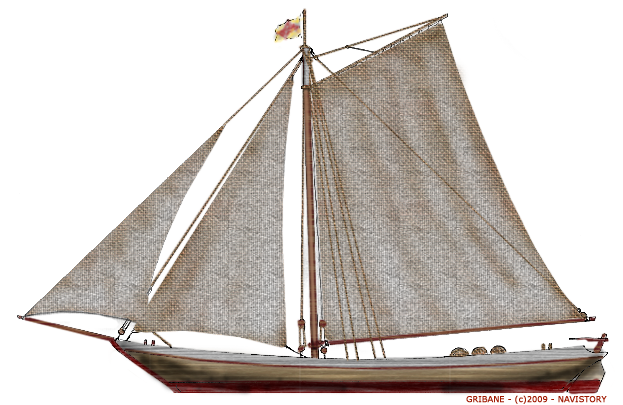
Archetype of the Seine riverboat, la Gribane, in the name probably derived from “Gabare” (also called Gabanne), had a nautical quality more important than the gabares of the Loire. Length of about twenty meters for eight wide and 90 tons, it is a flat-bottomed load boat that appeared in the 15th century (mentions but no engravings) and was the main cargo ship of Seine until its replacement in the 19th century by steamboats.
It was found at Seine-Maritime, from Rouen to Le Havre, on the Normandy and Picardy coast. Although wide, its ends are pointed, the stern is very inclined and the saffron large. It carries a single mast on the front rigged to the third with a sail with horn and boom, a staysail and a jib mounted on the boat.
The last of them, Joble, was motorized and preserved in the Marine Museum of the Seine. Gabanne is quoted as early as 1436. “Afterwards, the two Englishmen of the Crotoy had two boats, named Gabanne, by whom they often employed those of Abbeville. (Monstrelet) By a stop of the State Console of 1612, it is defined as being 50 to 60 tons.
Jalbut
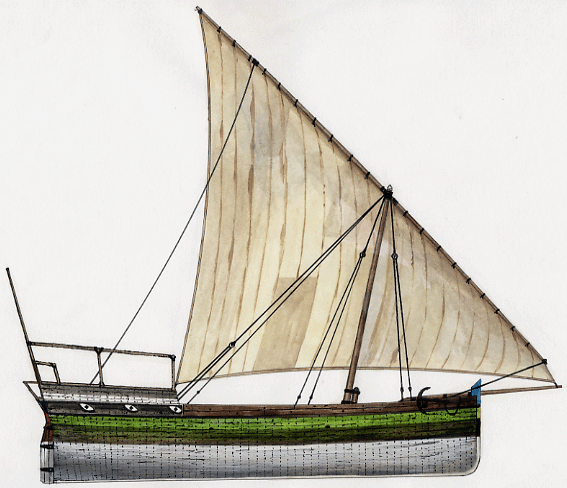
This type of ship, also called “Jalbut” with uncertain origins, probably Indian. It is an Arabian dhow, used in the Persian Gulf, in the eastern Mediterranean and on the spice routes, to the Indies. Coaster, it is characterized by its high loading volume, a straight stem and a flat transom. It is used and is still being manufactured today.
Keying Junk
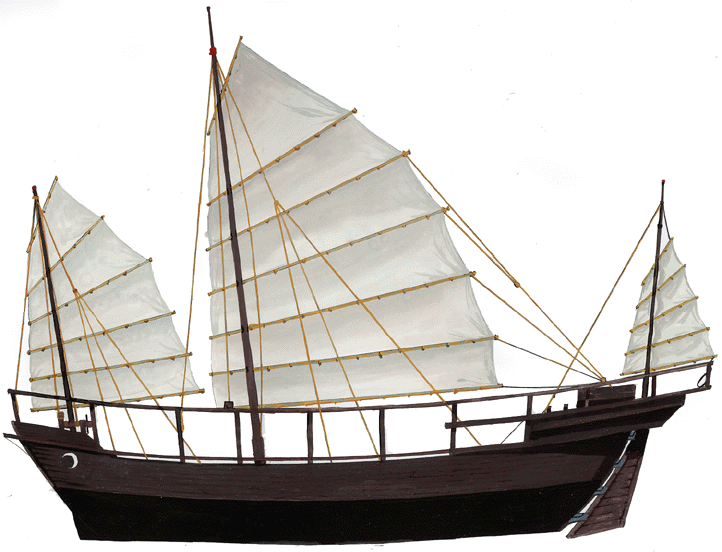
Keying is actually the name of this junk a relatively recent reconstruction by the Exeter Maritime Museum.
A few words about this type of ship universally known and emblematic of the Asian seas. The Junk could very well have been classified among the ancient ships since it was developed from the rafts of the Chinese Neolithic and other flat-bottomed boats used on the Yang-Tse Kiang and its tributaries.
Since then, its base has steadily improved to reach us today almost unchanged. The bimillenary coaster, the Junk, of the ancient Chinese Chu’an, but known to the Arabs under his Malay name, Djong, already had 100 ap. J.C. features the most modern features, including the axial rudder, bamboo sails easy to stir, and a flat-bottomed shell in prismatic shape, with the rear part wider than the front.
The junks were used for fishing as well as for transport or war. These vessels were slow, relatively maneuverable, though unable to tack, and especially able to ascend the rivers very upstream.
At the end of the Middle Ages, more and more imposing junks appeared, with the aim of trading with neighboring countries of China. In the 12th century, the junks called “steamships of silk”, and the first treasure-ship, have five or six masts including two mizzens mounted in tandem on the quarter-deck. They already have three or four bridges and can measure up to 60 meters long for 16 or 18 wide. But the largest of them was built under the reign of Emperor Ming Yongle, for the seven expeditions of Zeng He between 1405 and 1433. (See treasure-boat).
War Junk
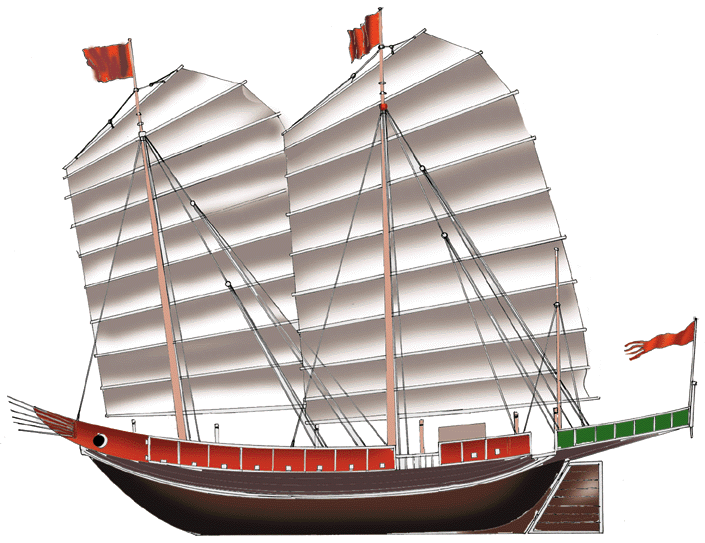
Since the first junks appeared, under antiquity, probably from 1500 to 2000 BC. JC., Their various users have constantly armed them, even if only with a few white weapons, to face the pirates who infested the intense trade routes between China and South-East Asia, and up to India.
But the first real war junks specifically conceived as such probably only existed with the widespread use of explosive black powder at the end of the thirteenth century. The “muskets” and the first heavy guns were quickly adapted to junks specially adapted to the tracking of pirates. Some of them, such as the one above, carry at the same time flares at the front, more destined to provoke fear than as offensive arms, and numerous light cannons, passing through small ports, embrasures of bulwarks.
As in the West, speed was quickly judged as a determining criterion, and the junks of war were also characterized by their finer shapes and lesser weight: The abandonment of billowing holds to maximize wearing was very much the case. The wing was also larger at the surface.
Junks like these were part of Zheng He’s expeditions around the world in the early 14th century. These junks of war were still, in 1870, when China began to equip Western ships, the main units of the fleets of maritime governors. Their cannon, like that of the forts, had scarcely evolved since the Middle Ages, and made more noise than that of evil.
Baochuan
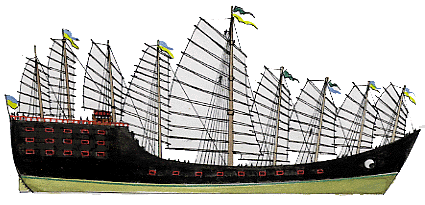
True Leviathan of the Medieval era, this ship represented a logical outcome of the Traditional Junk.
The largest tradtional Chinese vessels ever built were those of Admiral Zheng He’s fleet, called the “treasure boats” or Baochuan. They were sent by Emperor Ming Yongle to join the African coast, consisting of more than 200 junks of all sizes, ranging from the giant junk-admiral to 62 more conventional boats, down to the smallest auxiliaries.
The fleet included a very hierarchical set of 2 great commanders, 93 naval commanders, the equivalent of generals, 140 millerions and 406 centurions for 26,800 soldiers and 868 civilian officers, a finance reporter, a geographer, an instructor and two military judges, 180 medical officers and their assistants, while Zheng He himself (which was an imperial eunuch, trusted for this expedition) was assisted by 2 ordinances, 7 ambassadors, 10 young eunuchs, 53 chambellans.
In 1405, this fleet sailed with thousands of Imperial merchants and emissaries in order to establish contacts and open trading posts well beyond the traditional zone of influence of China (namely the China sea).
Operating to the east of the Portuguese, the Chinese descended to the Cape of Good Hope. But also discovered Indonesia, and it is possible that they have completed a round the world. This memorable expedition which ended in 1533 (Zheng He died in 1434, victim of the conspiracies of the Emperor’s advisers). The new emperor wanted to hear no more about this type of expeditions and China lost all appetite for the sea. This is only recently with the emergence of a powerful and modern navy that Zheng He was given a museum, numerous statues and all praises.
These treasure ships, according to the Chinese texts which reported the size of their dock, were junks, so flat-bottom ships of 130 to 150 meters long for 40 to 60 m of wide, estimated about 1500 to 2500 tons, with a crew of 1000 men and about 100 merchants and their families housed in the apartments of these ships with up to 6 decks. This has to be compared with the Santa Maria of Cristobal Colomb, almost a century later. The Baochuan was also given nine masts, on which were mounted up to 30 battened sails.
Dimensions that are questionable for wooden vessels, but it must be said that the very special technique of the Chinese, far ahead of Europe at the time on flat-bottomed ships, allowed a great rigidity, authorizing of such dimensions. Each of these giant junks had 16 to 30 huge cannons in order to impress the locals. Seven expeditions were launched in total, all under the command of Zheng He.
According to Gavin Menzies, a British submarine officer who supported this controversial thesis in 2000, it is possible that the Chinese had set foot on an island in the Amerindian continent, long before Columbus, and a map to support this claim was allegedly obtained by Nicolo da Conti, describing the coast and perhaps helping to convince Colomb.
Macao Patache
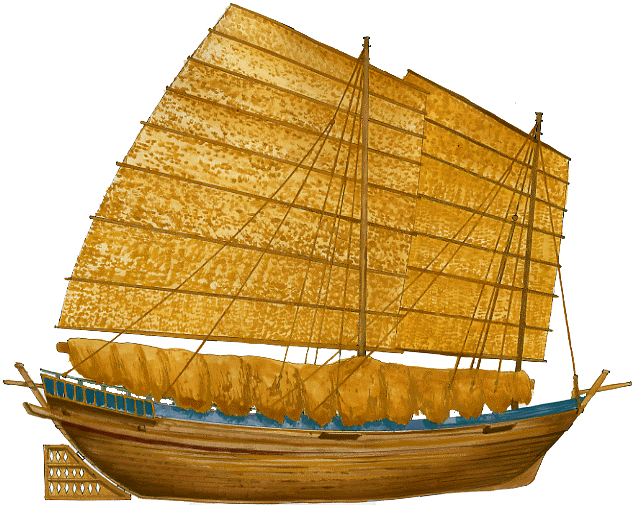
The Patache term covers a large number of light boats known and used by Arabs, Spaniards, Portuguese, Italians or even Dutch, Italians, Germans, under appellations like Bastas, Petas, Patasche, Pataggio. The Patache of Macao is, on the other hand, a sort of junk of local construction, proper to this port very well located on the trade routes between the china and the Indian Ocean. Strongly influenced by the junk, it has the main features, flat bottom, battened sails, wide hull at the back, fine front …
Macao’s patache has a bow-shaped prow and a small trimmer attached to the bow, and its triangular rudder serves as a drift. The local Patache also had a “roof” of Coconut thatch to protect cargo and crew during the monsoon and was decked. They disappeared slowly in the 20th century.
Pirlapore Patli
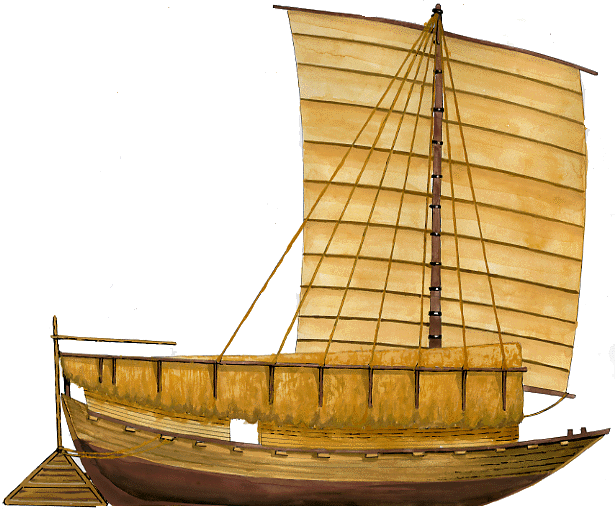
Also known as Patli, known and used by the present Pakistan and India for centuries, of origin hard to pin down, the Patile said of Mirlapore, the famous city of the Ganga which is at the origin is the traditional transport barge par excellence in western India.
A solid vessel with a flat bottom, the Patile recalls the junk in its principle. Like all river boats, it carries an enormous saffron, and in order not to lose space, its hull is not bridged, but only reinforced by transverse bars.
Its shade is very pronounced at the back, and a hut surmounts it, in a cane and covered with coconut thatch, sometimes integral, sometimes limited to the rear. This is surmounted by a maneuvering platform. Built in clapboard or in freeboard (in Pakistan), Patile sails as well as rowing, has a sail battened in coconut fibers. The Pakistani and Bangladesh Patile have a higher bow and stern and often two masts. They are still used and built.
Dhow
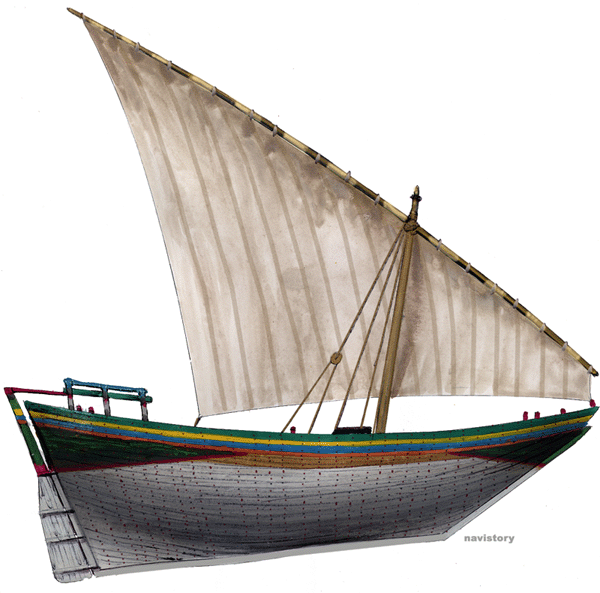
The Dhow is not an Arab ship, it is a veritable family of vessels sharing common characteristics, such as the hull, large (about 4 to 1), with straight cut lines, with three masterpieces whose bow, long and the keel, and the stern, less inclined, and one or two masts carrying sails Latin-setie.
The smallest ones are only eight meters for 50 tons. The larger ones, like the Baghala, up to 500 tons and more. Their construction has not varied since their appearance, presumably in the late Middle Ages. Dams were rarely decked to maximize load carrying. It was a coaster, which could be stranded on the shore, and resume the sea with the tide every day, like the cargo ships of antiquity.
Thanks to the simplicity of her rigging, the crew could be reduced to a few men. The Batel or Batil, Baqarah, Dinghy, Kotia, Odam, Daou, Balam, Mtepi, Baghala, Shuai, Zaima and Zarook are derivatives thereof. The dhows are always built of wood, although the propulsion has long been made by a robust diesel engine, see a large outboard motor. Some zarooks or Zarougs are also the favorite craft of traffickers and pirates from Madagascar to Somalia.
Sailing dinghies traditionally use the monsoon to transport dates or mangrove forests between India and the Persian Gulf. Some Dhows are more generally lighter and finer line derivatives that link Madagascar and the Bay of Bengal, still by coasting. Their construction was solid and in their time the Dhow was copied by the Portuguese, who created the caravel all in oak but based on the same architecture.
Kotia
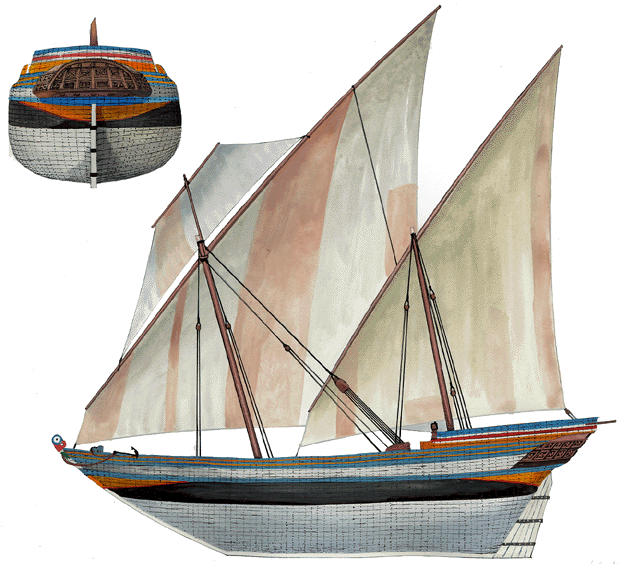
The Kotia is an Indian ship, a two-masted high-seas dinghy (30 meters by 8 meters), with a curved bow ending at the head of a protective parrot, a slender stern and a rear castle identical to the Baghala, reminiscent of the ships Europeans of the eighteenth century.
They carry about 10 crew and are generally decorated in bright colors. Their construction still goes on, but these ships tend to disappear and the know-how is almost lost.
Batil
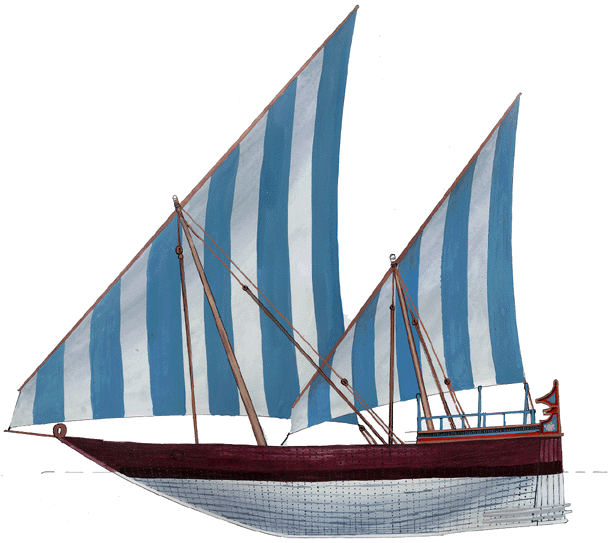
The Batil is an Indian coaster, akin to the Persian Gulf, always with two masts and generally measuring 20 meters by 6. Their stern is tapered, their keel cut in three parts with a very long bow and inclined, and a rear part identified.
The rudder is very massive and ends with a characteristic shape, as does the ovoid-shaped bow. A small tip in the front serves to rig the mainsail. The rudder does not have a longitudinal bar but a small crossbar connected to ropes fixed to the foremast and maneuvered by a hoist on the rear poop. These vessels disappeared in the mid-1950s.
Gayassa
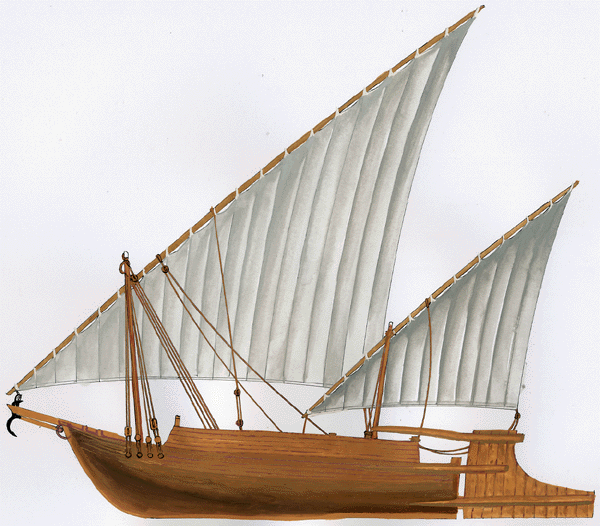
Its silhouette is familiar to all lovers of the Nile since the Middle Ages. It is a very old barge, perhaps the common ancestor of the first Arab dhows. It is a ship with a low draft, very low and very wide, with an enormous rudder, and with a very high prow.
They are probably derived from the old square sailing barges used to transport stone blocks from quarries to the Pharaonic shipyards. the antenna of their mainsail is very long, and often the masts are hollowed out of notches intended to facilitate their climbing to brew the sails. The Gayassa uses its immense canopy to ascend the Nile to the south, and returns by the current.
Mtepi
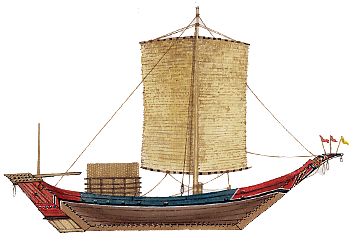
This coaster is one of the rare of Black Africa.
It is naturally related to the Arab Daou is common to all the east coast, and especially from Zanzibar to Kenya. Probably very ancient (10th century), it borrows from the ancient Egyptian builder certain characteristics like the lacing of the keel and the limbs with clinkers by coconut fibers. It does not have a bridge and is reinforced by transverse beams. The rudder has a large Saffron. These ships were very colorful but disappeared in the 20th Century.


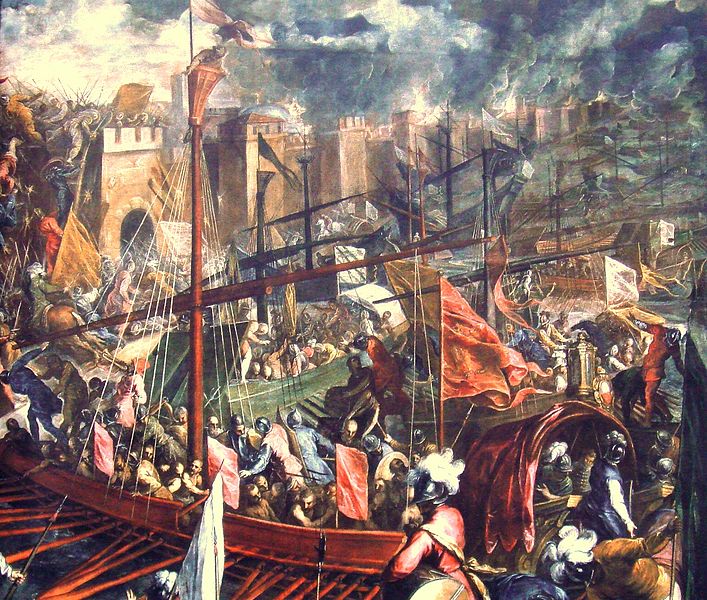
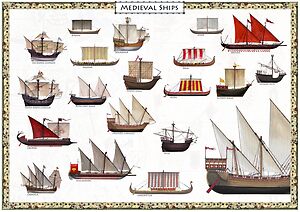


 Latest Facebook Entry -
Latest Facebook Entry -  X(Tweeter) Naval Encyclopedia's deck archive
X(Tweeter) Naval Encyclopedia's deck archive Instagram (@navalencyc)
Instagram (@navalencyc)





 Austrian Navy
Austrian Navy French Navy
French Navy Royal Navy
Royal Navy Armada Espanola
Armada Espanola K.u.K. Kriegsmarine
K.u.K. Kriegsmarine Dansk Marine
Dansk Marine Nautiko Hellenon
Nautiko Hellenon Koninklije Marine 1870
Koninklije Marine 1870 Marinha do Brasil
Marinha do Brasil Osmanlı Donanması
Osmanlı Donanması Marina Do Peru
Marina Do Peru Marinha do Portugal
Marinha do Portugal Regia Marina 1870
Regia Marina 1870 Nihhon Kaigun 1870
Nihhon Kaigun 1870 Preußische Marine 1870
Preußische Marine 1870 Russkiy Flot 1870
Russkiy Flot 1870 Svenska marinen
Svenska marinen Søværnet
Søværnet Union Navy
Union Navy Confederate Navy
Confederate Navy Armada de Argentina
Armada de Argentina Imperial Chinese Navy
Imperial Chinese Navy Marinha do Portugal
Marinha do Portugal Mexico
Mexico Kaiserliche Marine
Kaiserliche Marine 1898 US Navy
1898 US Navy Russkiy Flot
Russkiy Flot French Naval Aviation
French Naval Aviation Russian Naval Aviation
Russian Naval Aviation Sovietskiy Flot
Sovietskiy Flot Royal Canadian Navy
Royal Canadian Navy Royal Australian Navy
Royal Australian Navy RNZN Fleet
RNZN Fleet Chinese Navy 1937
Chinese Navy 1937 Kriegsmarine
Kriegsmarine Chilean Navy
Chilean Navy Danish Navy
Danish Navy Finnish Navy
Finnish Navy Hellenic Navy
Hellenic Navy Polish Navy
Polish Navy Romanian Navy
Romanian Navy Turkish Navy
Turkish Navy Royal Yugoslav Navy
Royal Yugoslav Navy Royal Thai Navy
Royal Thai Navy Minor Navies
Minor Navies Albania
Albania Austria
Austria Belgium
Belgium Columbia
Columbia Costa Rica
Costa Rica Cuba
Cuba Czechoslovakia
Czechoslovakia Dominican Republic
Dominican Republic Haiti
Haiti Hungary
Hungary Honduras
Honduras Estonia
Estonia Iceland
Iceland Eire
Eire Equador
Equador Iran
Iran Iraq
Iraq Latvia
Latvia Liberia
Liberia Lithuania
Lithuania Mandchukuo
Mandchukuo Morocco
Morocco Nicaragua
Nicaragua Persia
Persia San Salvador
San Salvador Sarawak
Sarawak Uruguay
Uruguay Venezuela
Venezuela Zanzibar
Zanzibar Warsaw Pact Navies
Warsaw Pact Navies Bulgaria
Bulgaria Hungary
Hungary

 Bundesmarine
Bundesmarine Dutch Navy
Dutch Navy Hellenic Navy
Hellenic Navy Marina Militare
Marina Militare Taiwanese Navy
Taiwanese Navy Chinese Navy
Chinese Navy Indian Navy
Indian Navy Indonesian Navy
Indonesian Navy JMSDF
JMSDF North Korean Navy
North Korean Navy Philippines Navy
Philippines Navy ROKN
ROKN IDF Navy
IDF Navy Royal New Zealand Navy
Royal New Zealand Navy Egyptian Navy
Egyptian Navy South African Navy
South African Navy

































 RN
RN
 Marine Nationale
Marine Nationale
 Soviet Navy
Soviet Navy
 dbodesign
dbodesign